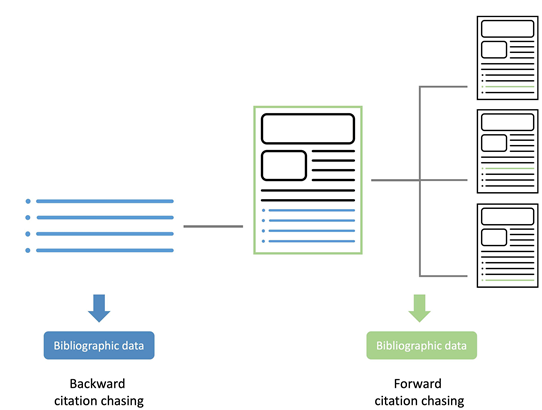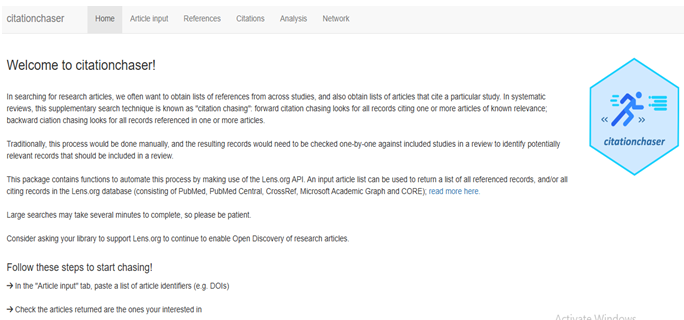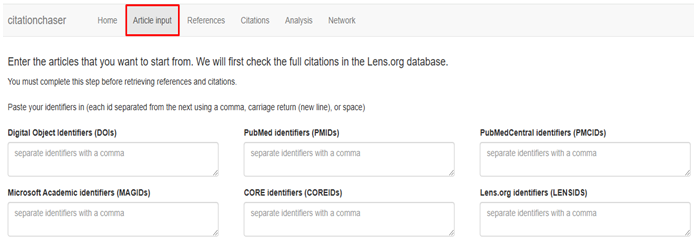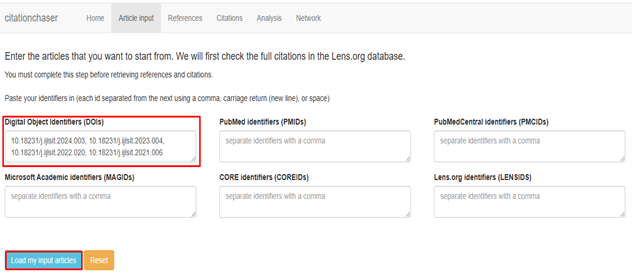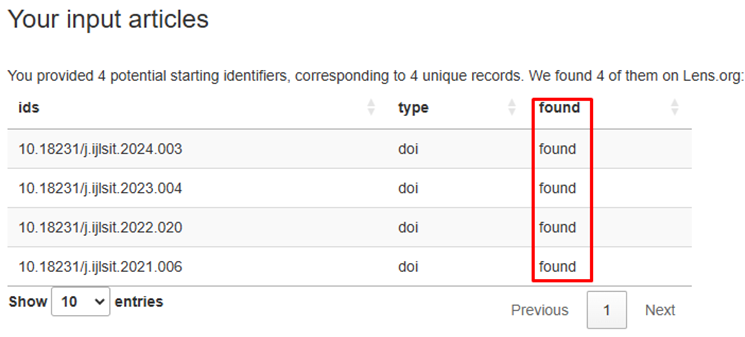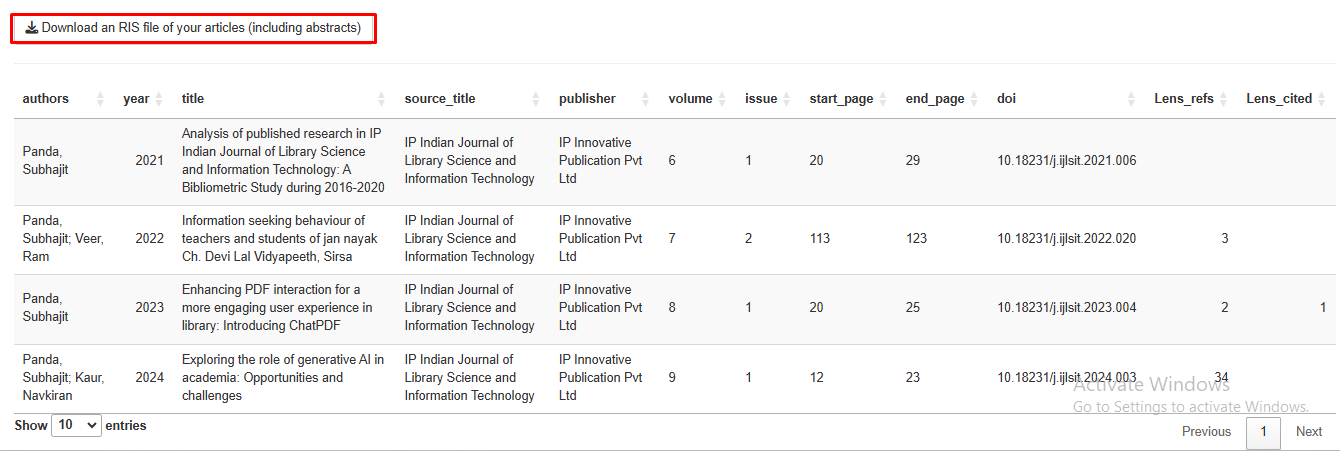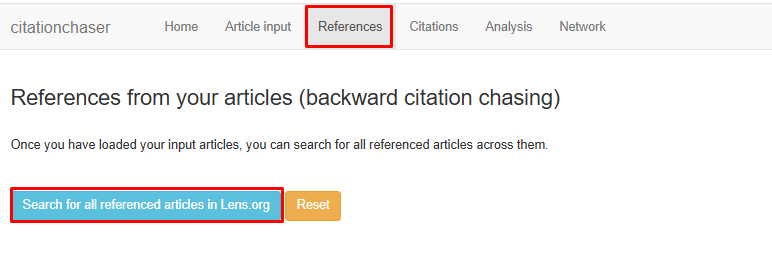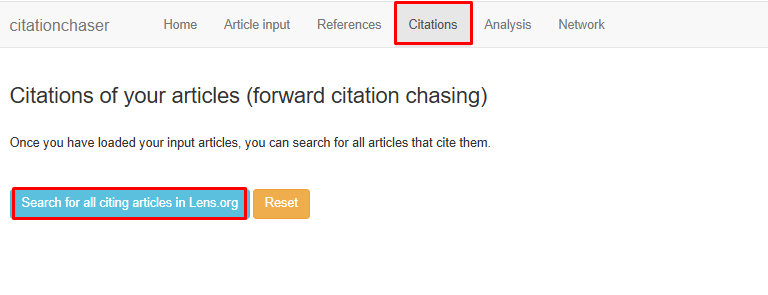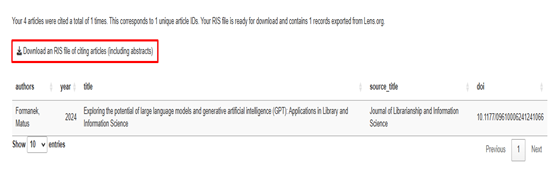Introduction
In academic research, a comprehensive literature search often requires more than simply locating individual articles; it demands a structured approach to uncover both the sources a study cites and the subsequent research that cites it.1 This dual process, known as citation chasing, is integral to systematic reviews and allows researchers to build a thorough foundation of relevant studies.2 Traditionally, citation chasing has been a labor-intensive process, requiring researchers to manually check each citation one by one to determine relevance, which can be time-consuming and prone to missed connections.3 Recognizing the need to streamline this process, Citationchaser was developed as an automated tool to facilitate citation chasing through the Lens.org API, providing a faster, more efficient way to track both cited and citing articles across extensive databases like PubMed, CrossRef, Microsoft Academic Graph, and CORE.4
Citationchaser, created by Neal Haddaway (2021),5 Senior Research Fellow at the Stockholm Environment Institute, offers researchers the flexibility to conduct citation chasing without requiring advanced coding skills. Available as an R package and a Shiny web application, Citationchaser supports both coders and non-coders in academic research by enabling open and efficient discovery of related studies. This paper provides an in-depth review of Citationchaser, exploring its features, efficiency, and potential impact on academic literature searches and systematic review processes.4
Study Objectives
The primary objective of this study is to assess the functionality and reliability of the Citationchaser tool as an effective component of research support services.
What is Citation Chasing ?
In systematic reviews, citation chasing is a supplementary search technique that enhances the discovery of relevant literature by tracing the research paths of other authors. This method helps researchers identify targeted studies by examining an article’s citations or finding other works that cite it.6 Citation chasing offers a structured way to explore scholarly networks and uncover additional, often essential, resources that might not surface in standard database searches. Citation chasing can be categorized into two types: backward citation chasing and forward citation chasing (Figure 1).
Backward citation chasing involves reviewing the references or bibliography within a source, such as a book or journal article, to identify foundational works the author used.7 By doing so, researchers can locate studies or sources considered authoritative and relevant by the original author. These cited works are typically older than the article being reviewed, hence the term "backward". 8 This approach is valuable for understanding the foundational literature in a field and discovering sources that shaped the development of an academic topic.9
Forward citation chasing (or cited reference searching) is the reverse process. Instead of looking back at what an article cites, forward citation chasing identifies subsequent studies that cite the article in question.7 This allows researchers to see how a specific work has influenced later studies, providing insights into its impact and relevance in ongoing research.9 Forward citation chasing relies on specialized databases, often called “citation indexes,” which track how frequently and by whom a work has been cited.8
Together, backward and forward citation chasing provide a comprehensive view of the academic landscape, helping researchers uncover both the foundational studies of a topic and the newer studies that have built upon it.
Several factors influence the effectiveness and efficiency of citation chasing 4, 10:
Currency: This refers to how current a resource is in tracking citations for its records. A considerable delay in updating citations can weaken the resource’s effectiveness for forward citation chasing, particularly for recent publications, potentially leaving significant gaps in the citation network.
Network Comprehensiveness: The completeness of the citation network depends on the extent to which reference lists are digitized and stored as citations. If a database selectively indexes journals, only part of the reference list for each article may be captured. Additionally, the resource’s ability to track citations from recently published articles affects the network’s thoroughness.
Coverage: This refers to the percentage of the research literature indexed by a bibliographic resource. Limited coverage increases the likelihood that relevant articles are missing from the database, which may disrupt citation chasing from the initial record.
Functionality: Some bibliographic resources restrict users from exporting multiple reference lists or lists of citing articles at once. This limitation can require reviewers to export records individually, a process that is time-consuming and reduces the overall efficiency of citation chasing.
Why use Citationchaser?
In evidence synthesis and systematic reviews, ensuring a comprehensive and unbiased search is crucial for selecting relevant studies.11 To achieve this, researchers typically employ several search strategies, such as designing complex Boolean searches within bibliometric databases, exploring grey literature through specific organizational websites, seeking expert recommendations, and using a supplementary technique, that is the citation chasing.7 Both backward and forward citation chasing techniques help researchers uncover studies that may not appear in standard database searches.
Organizations like the Cochrane Collaboration emphasize citation chasing in systematic reviews, particularly in fields like complex public health interventions.12 While backward citation chasing is considered essential, forward citation chasing is also recommended for more nuanced searches. However, manually handling these searches for a large number of articles can be time-consuming and inefficient, especially when managing 30 to 50 studies. The challenge lies in extracting all relevant references and citations, deduplicating them, and producing a refined list of unique sources.
Though some databases support citation chasing to a limited extent, they often have restrictions. For example, Web of Science allows forward citation chasing through its “marked list” feature, while Scopus provides both forward and backward citation chasing but within a confined database. However, these databases may not offer comprehensive coverage or bulk extraction options for large-scale citation chasing.
Citationchaser addresses these limitations by leveraging Lens.org’s extensive index, offering a powerful alternative for researchers. Developed by Neal Haddaway, Citationchaser (2021) is an open-source R package that uses Lens.org’s API to provide broad access to academic content.5 Lens.org aggregates data from major sources, including CrossRef, PubMed, PubMed Central, and CORE, with coverage in the range of 200 million records—comparable to some of the largest scholarly databases.13 Unlike Google Scholar, which restricts bulk data extraction, Lens.org allows Citationchaser to perform large-scale citation chasing across multiple sources, making it an invaluable tool for systematic reviews. 14
By using Citationchaser, researchers can efficiently manage the exhaustive task of citation chasing, streamline their search processes, and achieve a higher level of thoroughness in evidence synthesis without relying on costly commercial databases or facing export limitations. This functionality not only saves time but also supports the integrity of systematic reviews by helping researchers locate and screen all potentially relevant studies comprehensively.
Choice for a Library Professional - Citationchaser Shiny app
Citationchaser is available both as an R package and as a Shiny app (a web-based application).15 For library professionals, the Shiny app is often the preferred choice for the following reasons:
Ease of Use: The Citationchaser Shiny app is a free, user-friendly web application that requires no prior knowledge of coding or API integration, making it accessible to a broader range of users.
API Access: Using Citationchaser through the R package requires users to arrange access to the Lens.org API, which involves additional negotiation steps.
How Does the Web Application Work?
This section will disclose step by step through the Citationchaser web application and explore the different features available.
Step 1: Input article identifiers
At the very outset, open the web application using the link: https://estech.shinyapps.io/citationchaser/), the following homepage will be open (Figure 2).
To begin, click on the 'Article Input' tab, which will bring up the interface shown below (Figure 3):
Currently, six type of article identifiers are supported by Citationchaser:
Digital Object Identifiers (DOIs)
PubMed identifiers (PMIDs)
PubMedCentral identifiers (PMCIDs)
Microsoft Academic identifiers (MAGIDs)
CORE identifiers (COREIDs and)
Lens org identifiers (LENSIDS)
For bulk input, each identifiers should be separated from the next using a comma, carriage return (new line), or space.
Step 2: Load my input articles
To take an example, the DOIs of the articles from the author ‘Subhajit Panda’ in the ‘IP Indian Journal of Library Science and Information Technology’ journal is taken as a reference. The four sample DOIs are: 10.18231/j.ijlsit.2024.003, 10.18231/j.ijlsit.2023.004, 10.18231/j.ijlsit.2022.020, & 10.18231/j.ijlsit.2021.006 (Figure 4).
Simply enter the identifiers in the designated box for DOIs and click 'Load my input article.' The app will then indicate whether or not the article is found in the Lens.org database (Figure 5).
The same window also displays the details of the articles as indexed in the Lens.org database (Figure 6). Users can download the search results in RIS format, which includes article abstracts, providing valuable support for researchers conducting literature reviews.
Step 3: Search for backward citation chasing
To conduct backward citation chasing or a retrospective search, select the 'References' tab (Figure 7). Click on ‘Search for all referenced articles in Lens.org’ to display all articles referenced by the input articles (Figure 8).
One important note: the downloadable reference results in RIS format, including abstracts, will only include those references indexed in Lens.org. For example, in this sample of four articles, a total of 39 references were identified, but only three are available in the Lens.org.
Step 4: Perform forward citation chasing
To perform forward citation chasing then proceed to the ‘Citations’ tab and click on ‘Search for all citing articles in Lens.org’ (Figure 9).
One important note: the downloadable results for citing articles in RIS format, including abstracts, will only include citations that are indexed in Lens.org. For instance, in this sample of four articles, a single citing article was identified and is available in the Lens.org (Figure 10).
Advantages
There are several advantages of using Citationchaser for Researchers:
Automated Citation Chasing: Citationchaser streamlines the citation-chasing process, automating the retrieval of backward (references cited by a work) and forward (works that cite a specific article) citations. This saves researchers significant time, especially in systematic reviews and evidence synthesis.
Access to Comprehensive Databases: Leveraging the Lens.org database, Citationchaser covers a wide array of academic content, including sources from PubMed, CrossRef, and CORE, providing access to a broad scope of references in multiple disciplines.
User-Friendly Interface: The tool’s Shiny app version allows researchers to perform citation chasing without programming knowledge, making it accessible even to those unfamiliar with coding or API integration.
Integration of Bibliometric Data: By offering citation analysis within the tool, Citationchaser helps researchers track the influence and impact of specific articles, supporting deeper literature reviews and tracking the development of research topics over time.
Cost-Effectiveness: As an open-source tool, Citationchaser provides free access to citation-chasing capabilities that would otherwise require costly database subscriptions, particularly beneficial for independent researchers and institutions with limited resources.
Scope of Citationchaser in Research
Enhanced Literature Reviews: Citationchaser could significantly support researchers in conducting thorough literature reviews by providing a comprehensive view of a topic’s citation network, helping to locate relevant studies that may be missed in regular database searches.
Integration with Bibliometric Tools: Future integration with advanced bibliometric analysis platforms could enhance its network analysis features, providing researchers with in-depth mapping of research relationships similar to tools like VOSviewer or CiteSpace.
Expansion Beyond Lens.org: Incorporating additional databases in the future would increase Citationchaser's coverage, making it a more versatile tool for global researchers across various fields.
Potential for Broader Research Applications: With further development, Citationchaser could support more complex research applications, such as meta-analyses and scoping reviews, where comprehensive citation tracking is crucial.
Development of Advanced Network Visualization: Future updates could include more robust visualization tools for mapping citation networks, enabling researchers to better explore the connections and influences between studies within their field.
Limitations
The main limitation of Citationchaser is its strong dependency on the Lens.org database. For example, in backward citation chasing, the four sample papers together had a total of 94 references, yet Citationchaser identified only 39 of them. Similarly, in forward citation chasing, these four articles had received a total of 19 citations on Google Scholar, but Citationchaser could locate only one that was indexed in Lens.org.
The ‘Network’ tab currently lacks functionality, making it less useful for visualizing citation relationships. At this stage, it’s more effective to use dedicated bibliometric analysis tools, such as VOSviewer, CiteSpace, or Bibliometrix, for creating detailed network visualizations of the identified papers.
In terms of comprehensiveness, there are concerns about Citationchaser’s reliance on the Lens.org index, which historically depended on Microsoft Academic Graph. Since Microsoft Academic Graph was discontinued in December 2021, this may impact Lens.org's coverage going forward, potentially affecting Citationchaser's results.
Additionally, as an aggregator, Lens.org may experience delays in updating its records across multiple sources, which could mean that Citationchaser’s results don’t reflect the latest publications. This lag might result in missed citations or unrecognized newly published articles when using Citationchaser.
Future Scope
On the Citationchaser web application's homepage, two forthcoming features—'Analysis' and 'Network'—promise to significantly enhance the research experience. These additions will offer researchers powerful tools for deeper insight and connectivity. If Citationchaser integrates features similar to those on platforms like ResearchGate (for comprehensive research interest analysis), Scite (for advanced citation analysis), and Semantic Scholar (for network analysis), it could become an invaluable, all-in-one platform. Such capabilities would provide researchers with a seamless experience, allowing them to conduct a wide range of analyses within a single application.
Conclusion
This study highlights the potential of Citationchaser as a valuable tool for enhancing research efficiency in systematic reviews through automated citation chasing. By leveraging Lens.org’s extensive database, Citationchaser simplifies the retrieval of both backward and forward citations, making it accessible for researchers who may not have access to traditional citation indexes. However, limitations such as its dependence on Lens.org, coverage gaps due to the discontinuation of Microsoft Academic Graph, and underdeveloped network visualization suggest room for further improvement. Enhancing these areas would make Citationchaser a more comprehensive tool, capable of supporting a broader range of citation and bibliometric needs. Overall, Citationchaser demonstrates promise as a research support service, with future developments likely to strengthen its role in evidence synthesis and academic research.

